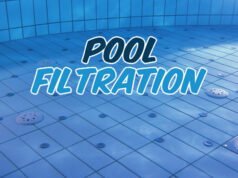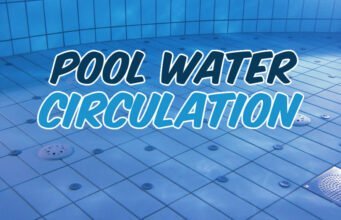Once again, let’s remember our last two texts…
We talked about the first two of the three pillars for maintaining the clarity of the pool:
So today we’ll talk about the third, last, and perhaps most important pillar of pool cleaning: disinfection.
Pool disinfection
To get straight to the point, what is pool disinfection?
If you search on Uncle Google, you will find something like this…
THE DISINFECTION OF THE POOL AIMS TO CONTROL THE MICROORGANISMS THAT DEVELOP IN THE WATER.
When we disinfect the pool, our intention is to reduce harmful microorganisms such as bacteria, algae, fungi, and viruses to acceptable levels.
The aim of disinfection is to prevent the transmission of infections that can be transmitted through contact with the pool.
Pools with inadequate disinfection, that is, contaminated water, can encourage the growth of algae and bacteria that initially present themselves with a greenish tint to the water.
If the pool undergoes a disinfection process, this green hue tends to settle and it is enough to aspirate to recover the beauty of the pool.
If the problem persists, the green of the water will become increasingly dark and end up completely blocking even the passage of light through the water.
How to disinfect the pool?
Currently, chlorine is the most commonly used element for pool disinfection.
It is usually used in tablets as it requires less maintenance.
Without a sufficient amount of chlorine in the pool, various types of bacteria can develop in the pool: Escherichia coli, Staphylococci, Pseudomonas, and several other “criminals”…
They can survive and even spread from person to person in a pool with incorrectly chlorinated water.
How much chlorine is needed to disinfect the pool?
The minimum amount of free chlorine in the pool is 1 PPM, meaning for every million liters of water, you will need one million liters of chlorine.
In other words, you need one gram of chlorine for every thousand liters of water in the pool.
Are these units driving you crazy? Don’t worry! Take a look at our text where we talk about units of measurement in the pool:
Volume, Weight, and Concentration Units in Pool Treatment
This amount of 1 PPM can eliminate almost all viruses and bacteria that can grow in the pool. Thus, with 1 PPM of free chlorine, the pool is theoretically ready to receive users.
BUT WHAT IF THE CHLORINE LEVEL DECREASES?
If the free chlorine starts to decrease, these troublemakers begin to develop again, and the risk of infection returns!
Therefore, it is essential to keep the free chlorine level always constant! One minute with low chlorine is one minute of bacteria multiplying!
The first sign of insufficient disinfection in the pool is the turbidity of the water. It begins to lose its shine and gradually becomes cloudy.
One full day without proper disinfection is already enough to notice the cloudy pool!
As time goes by, two days, three…
The pool becomes increasingly cloudy until it turns green. Who doesn’t remember the green pool at the 2016 Olympics here in Brazil?
The appearance of algae in the pool is the second sign that disinfection is not going well.
If nothing is done, the pool turns into that swamp, and you’ll need to read our complete guide to eliminating pool algae.
The pillars of a crystal clear pool
With good filtration and efficient circulation, these signs may take a little longer to appear. However, if you don’t worry about disinfecting the pool, that dark green hue and swampy appearance are inevitable results.
To keep the disinfection pillar up to date, it is recommended to use chlorine tablets as we have already mentioned in the text “How to keep pool water crystal clear and healthy.” Tablets are more durable and make pool maintenance much easier.
Using liquid chlorine or granulated chlorine may be ideal for quickly increasing the amount of chlorine in the pool, especially when you want to perform a shock treatment to eliminate contaminants from the water.
It is important for a good final result and the safety of those who use your pool that you understand that the pillars sustain water quality together!
Filtration, circulation, and disinfection are items that together result in a crystal clear and healthy pool. If one fails, problems will come mercilessly and inevitably!
IT IS USELESS TO PUT 200 KILOS OF CHLORINE IN THE POOL IF IT DOES NOT HAVE EFFICIENT FILTRATION AND/OR CIRCULATION!
Somehow, you may even get a crystal clear pool, but it certainly won’t be ready for use due to impurities at the bottom.
The pH in disinfection
When we talk about eliminating algae and bacteria using chlorine or other chemicals, we need to talk about pH.
The pH of the pool is basically the water’s acidity and is a determining factor in the efficiency of chlorine.
FREE CHLORINE CAN LOSE ITS DISINFECTING POWER WHEN THE POOL’S pH IS UNBALANCED.
If you study pool chemistry, you’ll see that free chlorine loses its disinfecting power in environments with a very high pH due to a drop in its Oxidation-Reduction Potential.
In environments with a very low pH, the pool becomes uncomfortable and even unsuitable for users, as it can cause eye and skin irritation.
The ideal is to always maintain the pool’s pH around 7.2.
Measuring the pool’s pH
First and foremost, you need a good tool to measure and correct the pH.
We can recommend the popular pH and chlorine test kits that inform the acidity as well as the amount of chlorine present in the pool.
We can also recommend using test strips that usually measure not only chlorine and pH but also alkalinity, which is another extremely important parameter for pool disinfection.
To keep this text from getting too long, we suggest reading three other texts on these parameters:
- The alkalinity of the pool
- The pH of the pool
- Free chlorine, combined chlorine, and total chlorine
To conclude this issue of measuring pH, alkalinity, and free chlorine, our recommendation is as follows:
Don’t skimp on your testing kit!
Use your testing kit as frequently as possible! The more you measure and correct the chlorine levels, the easier it will be to maintain a crystal-clear pool. Plus, the reagents in the testing kit usually have a shelf life of 6 months. In other words, if you don’t use it, it will expire!
Before you ask us how much chlorine to put in your pool, know that each pool has its unique chlorine demand. It’s hard to know because there are several factors you need to consider to determine how much chlorine your pool needs.
To learn more about the amount of chlorine to use, read the article:
- How much chlorine to add to the pool?
Within a few days or, in the worst-case scenario, a few weeks, using the testing kit, you can determine the amount of chlorine tablets your pool will need to maintain a residual disinfection of 1 PPM.
How to know the amount of chlorine needed to disinfect my pool?
To illustrate, you can do the following:
Put 3 chlorine tablets in the floating chlorinator or chlorine feeder. Use the testing kit approximately 24 hours later, and if you find too much chlorine in the pool, you can remove one chlorine tablet.
Alternatively, you can close the chlorine output of the floating chlorinator or close the small valve on the chlorine feeder.
As time goes by, the chlorine tablets will get smaller, and less chlorine will be added to the pool. In about two weeks, they will dissolve completely and need to be replaced.
But be aware! This floating chlorinator is not recommended for vinyl or fiberglass pools. These coatings can stain due to the chlorine that is concentrated on a particular side of the pool due to the action of the wind that normally pushes the float to the same side of the pool.
If your pool is of this type, prefer to use a chlorine feeder like the one in the image on the side.
It is installed inside the machine room and, unlike the floating chlorinator, does not pose a risk of causing stains on the pool.
Through trial and error, it is possible to find the correct amount of chlorine for your pool, including seasonal components (such as the season, the amount of sun, and the leaves that enter the pool in each season).
In places where the temperature varies greatly according to the seasons, it is easier to perceive that the amount of chlorine the pool needs is less on colder days than on hotter days.
It is also clear that when the pool is heavily used, the disinfection needs to be greater since more organic matter comes into contact with the water.
Keeping your pool disinfected
A POOL WITH THE CORRECT LEVEL OF CHLORINE DOES NOT HAVE A SMELL OF CHLORINE!
Contrary to popular belief, if you can smell chlorine in the pool, it means that it needs more chlorine!
We have already talked about this in a previous text and we will leave it here for you to check in case you don’t know:
- Pool water with a strong smell of chlorine? Learn what to do!
Auxiliary disinfection methods
Talking about pool disinfection is not just about chlorine!
There are even some places that cannot keep the pool disinfected using only chlorine as a disinfection method.
THERE COMES A TIME WHEN CHLORINE IS NOT ENOUGH!
At these times, it is necessary to rely on some other way of eliminating the villains that transmit diseases and infections in the pool.
The use of ionization systems is becoming more and more common.
Ozone generators are already gaining a large part of the market.
Ultraviolet disinfection for pools is also a reality.
All of these systems are excellent at eliminating algae and bacteria and, as a result, they can significantly reduce the amount of chlorine needed to keep the pool crystal clear.
To learn more about what to do when it is not possible to keep the pool crystal clear with chlorine alone, check out our text:
- When chlorine is not enough…
Disinfection: the last of the three pillars of pool cleaning
So that’s it! When the goal is to keep the pool crystal clear and ready for use, remember the three pillars:
- Filtration
- Circulation
- Disinfection
It’s important to deal with pool treatment in these three areas because each one affects the others.
We hope you enjoyed learning a little more about the importance of water disinfection in the pool.
If you liked the article, if it helped you in any way, click “Like” below. We are always producing quality content for the community that deals with pool treatment, and your feedback is extremely important and appreciated! Until next time! 😉








